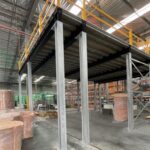Storing stock in a warehouse sounds like it should be simple. All you need to do put stock on pallets then put those pallets on pallet racking. It’s that easy!
In actual fact, warehouse storage is a lot more complicated than that.
When storing stock in a warehouse, it’s important that the stock is stored in an optimal way. This means that as much warehouse space is used as possible, and that warehouse workers know where everything is. This is what warehouse optimisation is all about.
What Is Warehouse Optimisation?
Warehouse optimisation aims to strike a balance between effective space utilisation, inventory accuracy, and efficient use of workforce. This is what warehouse optimisation is all about.
Space utilisation is all about making sure as much warehouse space is used as possible. Warehouse space, whether you’re renting it or own it, is expensive, and any wasted space is wasted money. It’s never going to be possible to use 100% of the space in a warehouse, but optimising warehouse space aims to use as much of it as possible. There are different types of pallet racking that can store pallets more densely than other types of pallet racking, but simply getting the most dense type of pallet racking isn’t always the best choice.
In a lot of ways, this is where space utilisation balances with inventory accuracy (and accessibility). Sure, something like drive in pallet racking allows for dense storage, but it doesn’t allow access to all pallets like selective pallet racking does. This all comes down to what’s being stored in a warehouse, how many pallets of each SKU are being stored, and the general operation of the business. Increasing the density of storage in a warehouse may be a good goal, but it doesn’t matter if most of your stock is inaccessible.
And this is where it all balances with having an efficient warehouse workforce. Like everything else, it’s always possible to simply hire more staff, theoretically making the warehouse work faster, but again, that costs money. It’s important to consider how much staff is needed to keep the warehouse running smoothly while also making sure it’s running as fast as possible.
Everything Works Together
In this way, warehouse optimisation is about making all of these things work together: space utilisation, inventory accuracy, and workforce.
When trying to optimise a warehouse, it’s about recognising where deficiencies lie, and trying to improve on them. However, this can’t be at the expense of other parts of the warehouse. For example, and as already been mentioned somewhat, it’s easy to improve the space utilisation of a warehouse simply by getting denser pallet racking. However, going denser with racking could lead to misplaced stock or an inefficient workforce.
With that in mind, optimising a warehouse is often about doing more than just one thing. It’s a give an take around all aspects of a warehouse’s operation and making it work as well as possible. There’s very rarely a single solution, and a solution that works for one business may not work for another.
Speak To Us About Your Warehouse
Whether you’re just looking for new pallet racking, a conveyor system to speed things up, or a larger warehouse project, we’re here to help. As mentioned, there’s seldom a single solution to a warehouse problem, but out experience means we’ve seen it all. We can often apply learnings and understanding from earlier projects to get the best out of a new client’s warehouse. Contact us today to talk about your needs.




